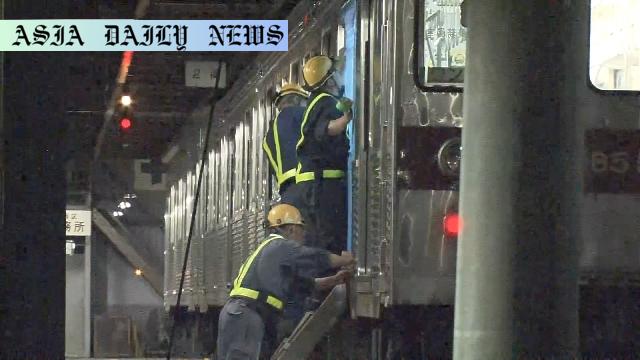Train collision: Strong winds cause fatal crash in Nagano Prefecture, leaving 1 dead and 2 injured.

Severe Accident in Nagano Prefecture
In an unfortunate turn of events on Wednesday, a train operated by Nagano Electric Railway collided with a shed, which had been dislodged and carried onto the tracks by strong winds. The tragedy took place in Suzaka City, within Nagano Prefecture, at approximately 6 p.m. The incident resulted in the death of a 56-year-old man, a company worker from Nagano City, while two male civil servants, aged 65 and 56, sustained mild head injuries. The collision caused significant damage, shattering train windows and bringing the entire railway system to a halt.
The deceased and the two injured individuals were traveling in the first carriage of the three-car train, which was scheduled to terminate at Nagano Station. Eyewitnesses reported how the metal structure of the shed, combined with the speed of the train, culminated in catastrophic consequences.
Investigating the Role of Extreme Weather
Upon investigation, authorities identified that the shed had a metal pipe frame. It was originally situated in a nearby field but was displaced due to strong winds. Meteorological conditions on the day were notably unstable, with moist air coupled with rising temperatures leading to the development of heavy rain clouds across the region. A tornado advisory was issued for northern Nagano Prefecture, including Suzaka City, shortly before the accident occurred. This highlights the potential dangers of operating in adverse weather conditions.
Precautions Against Future Tragedies
This devastating incident underscores the necessity of improved measures to predict and mitigate the impact of extreme weather events on public infrastructure. Adverse weather systems such as tornadoes and strong winds are becoming increasingly common, especially in areas prone to sudden atmospheric instability. Authorities need to implement stricter protocols, including advanced weather monitoring systems, more robustly securing objects prone to displacement, and providing timely alerts to prevent similar tragedies in the future.
Community and Government Response
The loss of the 56-year-old man has left the community in mourning. Local governments have urged citizens and businesses to ensure that outdoor structures are properly secured, emphasizing the unpredictability of weather conditions in the region. Additionally, transport authorities have been urged to establish more comprehensive risk assessments to protect their passengers in extreme weather situations. The broader aftermath of this incident has raised concerns regarding the preparedness of public infrastructure in the face of climate-related challenges.
Importance of Passenger Safety
Passenger safety remains a critical issue that demands immediate attention—especially in countries like Japan, renowned for their efficiency and safety standards in public transport. The Nagano train collision serves as a stark reminder of how unforeseen variables, such as weather-related incidents, can breach even stringent safety protocols. This event not only calls for operational reforms but also highlights the need for effective disaster-response strategies across regions.
Commentary
A Stark Reminder of Weather’s Unpredictability
The tragic train collision in Nagano Prefecture serves as a somber reminder of the unpredictable forces of nature and the devastating consequences they can bring. While Japan is often praised for its impeccable train infrastructure and safety protocols, this accident highlights how even minor structures, such as sheds, can turn into significant hazards during extreme weather. This prompts the question: How prepared are we to mitigate such risks, and what more can be done?
The Role of Weather Warnings
The presence of a tornado advisory in northern Nagano raises concerns about how effective these warnings were in preventing incidents like this. Tornadoes and high winds demand enhanced systems that not only alert communities but also assist in rapid risk assessment to identify vulnerable objects, such as sheds or equipment that could pose dangers to critical infrastructure. While weather forecasting technology has advanced significantly, its integration with public transport and urban planning systems remains inconsistent.
Lessons for Future Infrastructure Planning
Perhaps the most crucial takeaway from this incident is the urgent need to reassess infrastructure design and its resilience against extreme weather conditions. The tragic loss of life and injuries suffered here call for better emergency response mechanisms, continuous monitoring of high-risk areas, and public awareness campaigns urging individuals to secure items that could become airborne during storms. Advanced measures, such as weather-resistant structures near transportation routes, could also significantly reduce risks.
The Human Cost of Neglect
Ultimately, this tragic event is a reminder of the importance of valuing human lives above all else. With climate patterns becoming increasingly erratic, it is imperative for governments, businesses, and communities to collaborate in fostering a safer environment. By investing in preventive measures and prioritizing public safety, such accidents can be mitigated, ensuring tragedies like the Nagano train collision become a thing of the past.


